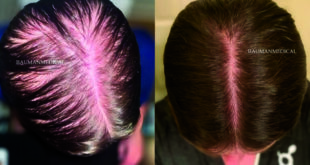By Matthew Stiebel, MD, FRCSC
 Biceps tendon tears- or why a love of spinach did not cause the Popeye deformity in your arm.
Biceps tendon tears- or why a love of spinach did not cause the Popeye deformity in your arm.
Tearing of the biceps tendon tends to happen most often in men aged 40-70. It can occur as a sharp “snap” when lifting or throwing. The tendon can tear at either its origin at the top of the shoulder or its insertion point at the elbow. If it tears at the top of the shoulder the muscle tends to “fall down” and bunch up mid humerus. If it tears at the elbow the muscle tends to retract proximally and also bunch up mid humerus. Either type of tear can give the knotted up cartoonish “Popeye deformity” of the biceps.
Despite the fact that the two types of tears can look similar- they are treated very differently. Tears from the proximal (top) of the shoulder often do not need to be treated surgically. They may provide a cosmetic deformity, but do not result in a tremendous lack of strength. The classic example is the former Denver quarterback John Elway. He tore his proximal biceps tendon and went on to win two superbowls without any surgical repair—claiming that the tear stopped much of his shoulder discomfort and allowed him to throw without pain.
Tears of the proximal biceps, however, can occur with tears of the rotator cuff. Full thickness rotator cuff tears do need to be fixed surgically. Also, there is some current debate about fixing proximal biceps tears in younger athletes because sometimes the muscle cramps with heavy lifting after it has ‘healed’ into its ‘Popeye’ position.
Palm Beach Sports Medicine
(561) 845-6000
www.pbsportsmed.com
Tears of the distal biceps are another animal altogether; they occur when the biceps tears at the elbow. While they can be treated non-surgically, they are most often repaired. If the biceps is not repaired at the elbow, significant loss of supination strength (turning the hand from palm down to palm up- like when you open a door knob) often occurs. It is for this reason that I usually recommend surgery for very active people who tear their distal biceps tendons—and usually recommend conservative treatment for those patients who tear their proximal biceps.
Most patients tend to ask me “why?” their biceps tendon tears in the first place. My suspicion is that while the muscle remains very strong, the tendon undergoes some chronic changes and ages with time and use. Why does our skin wrinkle or our hair turn gray? Why is it that Popeye, Bluto and Olive Oyl never figured out the problems inherent in their age-old love triangle? Why is it that people keep lending Wimpy money for hamburgers? While we may never know the full “why,” at least we know how to fix the “Popeye deformity” when it presents itself.
Check Also
Physical Therapy for the Brain
Have you noticed you have difficulty hearing your family and friends in a noisy restaurant? …
 South Florida Health and Wellness Magazine Health and Wellness Articles
South Florida Health and Wellness Magazine Health and Wellness Articles




